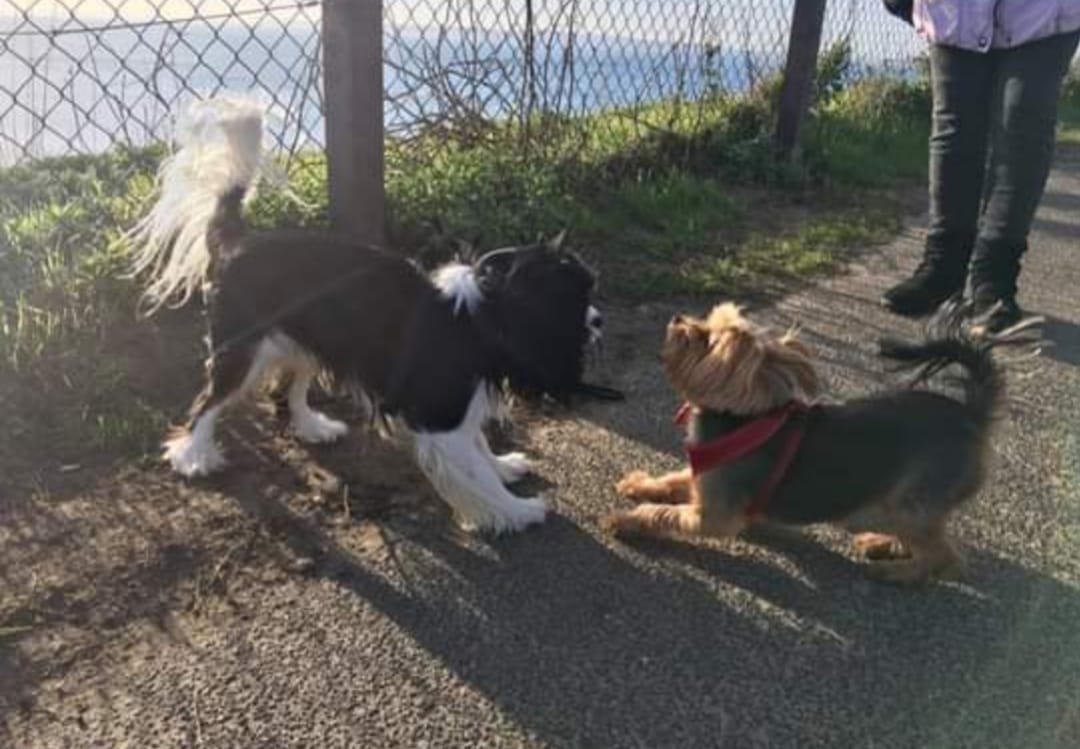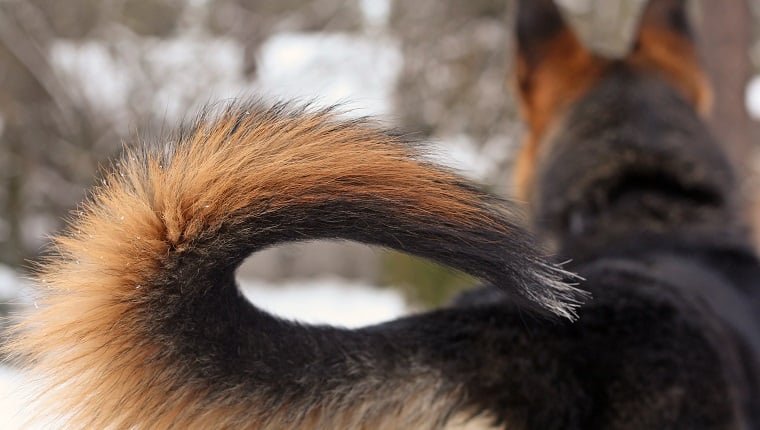The Tail
One of the most misunderstood features of a dog’s body… Their tail is wagging and so it must be friendly being a common misconception.
The tail of a dog is a nuanced subject. And a wag communicates: joy, anxiety, nervousness, excitement, caution and more…
Dogs use their tails for many different things. If you've ever seen a sports dog zip their way through a course, you might have seen them using their tail for balance and agility. Meanwhile, other dogs may use it to spread their scent and make their presence known.
Canines also use their tails to communicate with each other. Even if your dog has never been part of a pack, those instincts still exist.
Before we learn to speak “tail,” we must recognise that the neutral or natural position of a dog’s tail varies by breed. Some dogs have tails that hang down near their heels when they are relaxed. But some dogs, like Beagles, hold their tails more vertically. Others like Greyhounds and Whippets may be more inclined to curl their tails lower. Still others, like Pugs and Boston Terriers, have tails that coil tightly against the body and don’t wag at all.
We are going to be looking for some of the following:
positioning of the tail
is the tail tense or relaxed?
the movement of the tail
Tail position may indicate:
Preparedness or agitation. When dogs are alert, they stand with their ears up and tails raised. This posture indicates that they are watching and ready to confront whatever caught their attention.
Negotiation. When a dog suddenly stops wagging his tail and freezes, it may mean that he wants divert a threat and avoid a scuffle. Many dogs do this when petted by strangers to communicate that they don’t want to interact with them.
Display of assertiveness or aggression. When a tail moves from a neutral position to a vertical one or arches over the back, it indicates that the dog may have shifted into a different intention and it may well be a warning a fight or scuffle could break out. This high tail position also releases more of the dog’s scent from the anal glands which announces their arrival and marks territory.
Lowered tail. When a tail moves from the neutral position to a lower one, the dog may be showing that it is not a threat. If the tail is tucked tightly between the rear legs, the dog is likely feeling uncomfortable or fearful. They may be anticipating something they don’t want to happen and are asking not to be harmed. This lower tail position reduces the amount of scent emitted from the anal glands and allows the dog to remain in the background or fly under the radar.
Curiosity. When a dog is curious about something they may hold their tail straight out in a horizontal position. But for other breeds this could be a design default.
Happiness. When a dog is happy, they hold their tail in a neutral or slightly raised position and add a healthy wag.
The rate at which a tail moves adds further meaning to canine communication.
Wagging speed may indicate:
Excitement. The faster the wag, the more excited the dog. A tail wag may range from very slow to extremely rapid (known as flagging). Sometimes the dog’s tail wags so fast that it appears to vibrate.
Insecurity. A dog that is tentative about meeting a new person or another dog may wag their tail ever so slightly to indicate that they are insecure.
Friendliness. A dog that is very friendly may wag their tail more freely and even wiggle their hips at the same time.
Assertiveness. When a dog wags their tail very fast while holding it vertically, they may be asserting themselves strongly.
Let’s break down “tail speak”…
Full body wag
You probably see this wag when you come home. Your dog welcomes you with a tail wagging in a big circle. You’ll also see them moving their entire body from side-to-side in a loose way. A full body wag is obvious when you see the tail hitting either side of the bum and what is noticeable is that the wag is both sided not only one sided…
See a full body, excited, friendly wag by Merlin the Cavalier King Charles with his vet in the video below
These tails are hugging each other they are proper bum cheek wags
Fast and shaky
When you see a fast, vigorous, almost shaking tail on a dog, take it as a cue of excitement, nervousness, tension and/or hostility. The dog could spring into action at any moment. This could be play. “This is a highly aroused dog .” High arousal can turn into something else more intense.
If the tail is hardly moving apart from a shaking tip the more tense it is. Tense excitement like this can turn and over bubble into something less desirable. It can also turn into a wider wag or a lovely play or a wrestle if between dogs. We would want to be looking at the rest of the body language and any changes in tail movement as well as how both dogs are responding. Is the approaching dog proud and strutting and whining and excited to show themselves. Do they have considerate posturing and do they respect personal boundaries?
The wider the tail wag (i.e. the more space it covers from side to side) but moving fast the less tense it is.
Dogs may approach each other like this and then move in a soft angle to sniff the under carriage. Keep watching those tails because they could change at any moment. If they suddenly become stiff and still this is a sign of increased tension and a potential change of feelings.
Slow wag
Is it unsure? The dog seems to be contemplating his next move. Proceed with some caution.
High and stiff tail, no movement
This high, stiff tail usually speaks of confidence and alertness. Are they wanting to be seen and noticed?
…the higher the tail, the more assertive the dog
But when the tail is high and stiff and other dogs are near, it could also be a display of assertiveness. And, if the high stiff tail is in combination with raised hackles, tension throughout the body and face, with slow stiff movement - it’s a warning sign for caution.
See any teeth, a wrinkled nose? Get out of there.
Some dogs are designed with a tail that curls high and over the back e.g. Tibetan Terriers, Huskies, Pugs etc. And will be hard to read as this is their tail in both neutral and tense states at the same time. You would need to look at other the body signals to read them.
Merlin my dog walks mostly with a high curved tail as he is very sure of himself.
What can we tell about the tails on the dogs below?
Write down your observations, how the dogs may be feeling, how you are feeling looking at the picture and your analysis of what the tail means.
1
2
Wagging on the right
“There is research that suggests that when a dog wags its tail on the right side, it’s considered more likely to be friendly than when a dog wags its tail on the left side of its body,” Hartstein. “right to bright” is how I remember this. For my dog he also holds it tense and to the right when he is emboldened or feels confident in himself.
Researchers found that dogs wagged their tails to the right when they wanted to approach something, like their owner, but wagged their tails to the left when they were met with something they weren’t to sure of, like a dog with an unfriendly posture.
However, all dogs are individuals and it’s important to note and observe what if anything your dog means when it holds its tail either left or right and when it wags it in one direction only.
Below Merlin has just passed his neighbour who he has turf wars with. Note which direction he is holding his tail…
Neutral tail
You would need to identify a neutral tail by observing how different breeds hold different neutral positions. What position is a neutral tail on your dog?
Tail horizontal
potentially curious but if coupled with a tense body this could be a warning sign. Or as with pointers it’s a breed trait when they are literally “pointing”.
Tucked tail
Could be hiding scent, I’m not happy, fearful, insecure, anxious, apprehensive. “you are too close!”
Tail low
Potential readings:
Unhappy.
Low energy. Feeling off.
Feeling insecure and tucking away their scent.
Feeling unwell.
Anxiety.
But remember some breeds like the sighthounds have a naturally low tail which is their neutral position…
Some relaxed tails at the end of a play date
Lastly, note down your observations about the two dogs in this scenario with the cat.
Dog 1 is the dog on the left and Dog 2 is the dog on the right. How would you interpret the tails?
Let’s speak tail together
How the tail can be misleading and we need to look at the rest of the body
Have a watch of the video of these two dogs interacting. What do you notice? And see the explanation below.




















